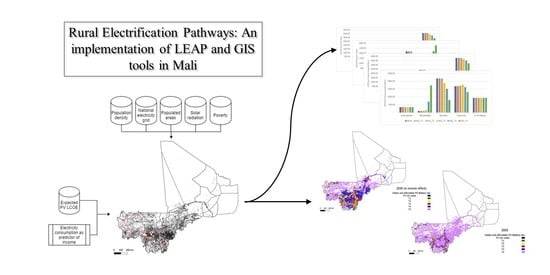Rural Electrification Pathways: An Implementation of LEAP and GIS Tools in Mali
Abstract
:1. Introduction
2. Materials and Methods
3. Results
4. Discussion
5. Conclusions
Author Contributions
Funding
Institutional Review Board Statement
Informed Consent Statement
Data Availability Statement
Acknowledgments
Conflicts of Interest
References
- World Bank. Rural Population (% of Total Population)|Data. Available online: https://data.worldbank.org/indicator/SP.RUR.TOTL.ZS (accessed on 24 February 2021).
- World Bank. Access to Electricity, Rural (% of Rural Population)|Data. Available online: https://data.worldbank.org/indicator/EG.ELC.ACCS.RU.ZS (accessed on 24 February 2021).
- World Bank. Access to Electricity, Rural (% of Rural Population)—Sub-Saharan Africa (Excluding High Income)|Data. Available online: https://data.worldbank.org/indicator/EG.ELC.ACCS.RU.ZS?locations=ZF (accessed on 24 February 2021).
- Kumar, A.; Sah, B.; Singh, A.R.; Deng, Y.; He, X.; Kumar, P.; Bansal, R. A review of multi criteria decision making (MCDM) towards sustainable renewable energy development. Renew. Sustain. Energy Rev. 2017, 69, 596–609. [Google Scholar] [CrossRef]
- Bhatia, M.; Angelou, N. Beyond Connections: Energy Access Redefined; Technical Report 008/15; World Bank: Washington, DC, USA, 2010; Available online: https://openknowledge.worldbank.org/handle/10986/24368 (accessed on 24 February 2021).
- Dinkelman, T. The Effects of Rural Electrification on Employment: New Evidence from South Africa. Am. Econ. Rev. 2011, 101, 3078–3108. [Google Scholar] [CrossRef] [Green Version]
- Yimen, N.; Hamandjoda, O.; Meva’A, L.; Ndzana, B.; Nganhou, J. Analyzing of a Photovoltaic/Wind/Biogas/Pumped-Hydro Off-Grid Hybrid System for Rural Electrification in Sub-Saharan Africa—Case study of Djoundé in Northern Cameroon. Energies 2018, 11, 2644. [Google Scholar] [CrossRef] [Green Version]
- Riva, F. When complexity turns into local prosperity: A system dynamics approach to meeting the challenges of the rural electricity-development nexus. Energy Sustain. Dev. 2020, 59, 226–242. [Google Scholar] [CrossRef]
- Falchetta, G.; Dagnachew, A.G.; Hof, A.F.; Milne, D.J. The role of regulatory, market and governance risk for electricity access investment in sub-Saharan Africa. Energy Sustain. Dev. 2021, 62, 136–150. [Google Scholar] [CrossRef]
- Kizilcec, V.; Parikh, P. Solar Home Systems: A comprehensive literature review for Sub-Saharan Africa. Energy Sustain. Dev. 2020, 58, 78–89. [Google Scholar] [CrossRef]
- van Els, R.H.; Vianna, J.N.D.S.; Brasil, A.C.P. The Brazilian experience of rural electrification in the Amazon with decentralized generation—The need to change the paradigm from electrification to development. Renew. Sustain. Energy Rev. 2012, 16, 1450–1461. [Google Scholar] [CrossRef]
- Baurzhan, S.; Jenkins, G.P. Off-grid solar PV: Is it an affordable or appropriate solution for rural electrification in Sub-Saharan African countries? Renew. Sustain. Energy Rev. 2016, 60, 1405–1418. [Google Scholar] [CrossRef]
- Szabó, S.; Bódis, K.; Huld, T.; Moner-Girona, M. Energy solutions in rural Africa: Mapping electrification costs of distributed solar and diesel generation versus grid extension. Environ. Res. Lett. 2011, 6, 034002. [Google Scholar] [CrossRef]
- Barasa, M.; Bogdanov, D.; Oyewo, A.S.; Breyer, C. A cost optimal resolution for Sub-Saharan Africa powered by 100% renewables in 2030. Renew. Sustain. Energy Rev. 2018, 92, 440–457. [Google Scholar] [CrossRef]
- Jahangiri, M.; Soulouknga, M.H.; Bardei, F.K.; Shamsabadi, A.A.; Akinlabi, E.T.; Sichilalu, S.M.; Mostafaeipour, A. Techno-econo-environmental optimal operation of grid-wind-solar electricity generation with hydrogen storage system for domestic scale, case study in Chad. Int. J. Hydrogen Energy 2019, 44, 28613–28628. [Google Scholar] [CrossRef]
- Parrado, C.; Girard, A.; Simon, F.; Fuentealba, E. 2050 LCOE (Levelized Cost of Energy) projection for a hybrid PV (photovoltaic)-CSP (concentrated solar power) plant in the Atacama Desert, Chile. Energy 2016, 94, 422–430. [Google Scholar] [CrossRef]
- Hernández-Moro, J.; Martínez-Duart, J. Analytical model for solar PV and CSP electricity costs: Present LCOE values and their future evolution. Renew. Sustain. Energy Rev. 2013, 20, 119–132. [Google Scholar] [CrossRef]
- Wamukonya, N.; Davis, M. Socio-economic impacts of rural electrification in Namibia: Comparisons between grid, solar and unelectrified households. Energy Sustain. Dev. 2001, 5, 5–13. [Google Scholar] [CrossRef]
- Sen, R.; Bhattacharyya, S.C. Off-grid electricity generation with renewable energy technologies in India: An application of HOMER. Renew. Energy 2014, 62, 388–398. [Google Scholar] [CrossRef]
- Bos, K.; Chaplin, D.; Mamun, A. Benefits and challenges of expanding grid electricity in Africa: A review of rigorous evidence on household impacts in developing countries. Energy Sustain. Dev. 2018, 44, 64–77. [Google Scholar] [CrossRef]
- Ehnberg, J.; Ahlborg, H.; Hartvigsson, E. Approach for flexible and adaptive distribution and transformation design in rural electrification and its implications. Energy Sustain. Dev. 2020, 54, 101–110. [Google Scholar] [CrossRef]
- Isa, Z.; al Sayed, A.R.M.; Kun, S.S. Review paper on economic growth—Aggregate energy consumption nexus. Int. J. Energy Econ. Policy 2015, 5, 385–401. [Google Scholar]
- Bridge, B.A.; Adhikari, D.; Fontenla, M. Household-level effects of electricity on income. Energy Econ. 2016, 58, 222–228. [Google Scholar] [CrossRef] [Green Version]
- Narayan, P.K.; Smyth, R. Electricity consumption, employment and real income in Australia evidence from multivariate Granger causality tests. Energy Policy 2005, 33, 1109–1116. [Google Scholar] [CrossRef]
- Zhu, X.; Li, L.; Zhou, K.; Zhang, X.; Yang, S. A meta-analysis on the price elasticity and income elasticity of residential electricity demand. J. Clean. Prod. 2018, 201, 169–177. [Google Scholar] [CrossRef]
- Obermaier, M.; Szklo, A.; La Rovere, E.L.; Rosa, L.P. An assessment of electricity and income distributional trends following rural electrification in poor northeast Brazil. Energy Policy 2012, 49, 531–540. [Google Scholar] [CrossRef]
- Francisco, E.D.R.; Aranha, F.; Zambaldi, F.; Goldszmidt, R. Electricity consumption as a predictor of household income: An spatial statistics approach. In Proceedings of the GEOINFO 2006—8th Brazilian Symposium on GeoInformatics, Campos do Jordão, Brazil, 19–22 November 2006. [Google Scholar]
- Opiyo, N.N. How basic access to electricity stimulates temporally increasing load demands by households in rural developing communities. Energy Sustain. Dev. 2020, 59, 97–106. [Google Scholar] [CrossRef]
- ONSSET. Available online: http://www.onsset.org/ (accessed on 27 May 2021).
- Bissiri, M.; Moura, P.; Figueiredo, N.C.; da Silva, P.P. A geospatial approach towards defining cost-optimal electrification pathways in West Africa. Energy 2020, 200, 117471. [Google Scholar] [CrossRef]
- Tesfahunegn, H.; Nwosu, N.; Lee, E.; Shirley, R. Unlocking Utilities of the Future in Sub-Saharan Africa: An Optimization Analysis of Grid Integration Opportunities in Uganda. In Proceedings of the 2020 IEEE PES/IAS PowerAfrica, Virtual Conference, 25–28 August 2020; pp. 1–5. [Google Scholar]
- Jean, W.; Arcela, A.; Van Els, R.H.; Junior, A.C.P.B.; Echeverry, S.M.V.; De Miranda, A.R.S.; De Souza, J.S.A. A GIS for Rural Electrification Strategies in the Brazilian Amazon. Pap. Appl. Geogr. 2021, 1–17. [Google Scholar] [CrossRef]
- Korkovelos, A.; Khavari, B.; Sahlberg, A.; Howells, M.; Arderne, C.; Mentis, D. The Role of Open Access Data in Geospatial Electrification Planning and the Achievement of SDG7. An OnSSET-Based Case Study for Malawi. Energies 2019, 12, 1395, Erratum in 2020, 13, 5044. [Google Scholar] [CrossRef] [Green Version]
- Menghwani, V.; Zerriffi, H.; Korkovelos, A.; Khavari, B.; Sahlberg, A.; Howells, M.; Mentis, D. Planning with justice: Using spatial modelling to incorporate justice in electricity pricing—The case of Tanzania. Appl. Energy 2020, 264, 114749. [Google Scholar] [CrossRef]
- World Bank. Population, Total—Mali|Data. Available online: https://data.worldbank.org/indicator/SP.POP.TOTL?locations=ML (accessed on 24 February 2021).
- World Bank. Mali|Data. Available online: https://data.worldbank.org/country/mali (accessed on 24 February 2021).
- Traore, V.; Tiéblé, D. Menages et Caracteristiques de L’habitat au Mali; Institut National de la Statistique INSAT: Bamako, Mali, 2012. [Google Scholar]
- SIE. Rapport D’activité de Système D’information Energétique (SIE); SIE: Bamako, Mali, 2018. [Google Scholar]
- NRECA International, Ltd. Reducing the Cost of Grid Extension for Rural Electrification; Energy Sector Management Assistance Programme (ESMAP): Washington, DC, USA, 2000; Volume ESM 227, Available online: https://openknowledge.worldbank.org/handle/10986/20326 (accessed on 26 April 2021).
- Jjaeger. Hybrid Mini-Grids for Rural Electrification—Lessons Learned; The Alliance for Rural Electrification (ARE): Brussels, Belgium, 3 April 2016; Available online: https://www.ruralelec.org/publications/hybrid-mini-grids-rural-electrification-lessons-learned (accessed on 26 April 2021).
- Agence Beninoise d’Electrification Rurale et de Maitrise d’Energie. Agence Beninoise d’Electrification Rurale et de Maitrise d’Energie; ABERME/MIERT: Cotonou, Benin, 2019. [Google Scholar]
- OpenStreetMap Contributors. Planet Dump. 2017. Available online: https://www.openstreetmap.org (accessed on 24 February 2021).
- ECOWREX. Mali—Electricity Transmission Network—ENERGYDATA.INFO 2018. Available online: https://energydata.info/dataset/mali-electricity-transmission-network-2014 (accessed on 24 February 2021).
- Thiruselvi, D.; Kumar, P.S.; Kumar, M.A.; Lay, C.-H.; Aathika, S.; Mani, Y.; Jagadiswary, D.; Dhanasekaran, A.; Shanmugam, P.; Sivanesan, S.; et al. A critical review on global trends in biogas scenario with its up-gradation techniques for fuel cell and future perspectives. Int. J. Hydrogen Energy 2021, 46, 16734–16750. [Google Scholar] [CrossRef]
- Pintér, G. The Potential Role of Power-to-Gas Technology Connected to Photovoltaic Power Plants in the Visegrad Countries—A Case Study. Energies 2020, 13, 6408. [Google Scholar] [CrossRef]
- Zepter, J.; Engelhardt, J.; Gabderakhmanova, T.; Marinelli, M. Empirical Validation of a Biogas Plant Simulation Model and Analysis of Biogas Upgrading Potentials. Energies 2021, 14, 2424. [Google Scholar] [CrossRef]
- Lamidi, R.O.; Jiang, L.; Wang, Y.; Pathare, P.B.; Aguilar, M.C.; Wang, R.; Eshoul, N.M.; Roskilly, A.P. Techno-Economic Analysis of a Cogeneration System for Post-Harvest Loss Reduction: A Case Study in Sub-Saharan Rural Community. Energies 2019, 12, 872. [Google Scholar] [CrossRef] [Green Version]
- Masip, Y.; Gutierrez, A.; Morales, J.; Campo, A.; Valín, M. Integrated Renewable Energy System based on IREOM Model and Spatial–Temporal Series for Isolated Rural Areas in the Region of Valparaiso, Chile. Energies 2019, 12, 1110. [Google Scholar] [CrossRef] [Green Version]
- Diarra, D.-C.; Akuffo, F. Solar photovoltaic in Mali: Potential and constraints. Energy Convers. Manag. 2002, 43, 151–163. [Google Scholar] [CrossRef]
- Mohammed, Y.; Mustafa, M.; Bashir, N.; Mokhtar, A. Renewable energy resources for distributed power generation in Nigeria: A review of the potential. Renew. Sustain. Energy Rev. 2013, 22, 257–268. [Google Scholar] [CrossRef]
- Thiam, D.-R. Renewable decentralized in developing countries: Appraisal from microgrids project in Senegal. Renew. Energy 2010, 35, 1615–1623. [Google Scholar] [CrossRef]
- SEI. LEAP. Available online: https://leap.sei.org/ (accessed on 24 February 2021).
- QGIS. Welcome to the QGIS Project! Available online: https://qgis.org/en/site/ (accessed on 24 February 2021).
- McPherson, M.; Karney, B. Long-term scenario alternatives and their implications: LEAP model application of Panama’s electricity sector. Energy Policy 2014, 68, 146–157. [Google Scholar] [CrossRef]
- SIE. Rapport D’activité de Système d’Information Energétique—Mali; SIE: Bamako, Mali, 2014. [Google Scholar]
- EDM SA. Rapport D’activité 2017; EDM SA: Bamako, Mali, 2017. [Google Scholar]
- Centre pour les Energies Renouvelables et lÉfficacité Energetique de la CEDEAO (CEREEC). Plans d’Action Nationaux des Energies Renouvelables (PANER) du Mali; CEREEC/CEDEAO ECOWAS: Bamako, Mali, 2015. [Google Scholar]
- African Development Bank Group. Renewable Energy in Africa—Mali Country Profile—2015; African Development Bank Group: Abidjan, Ivory Coast, 2015; Available online: https://www.afdb.org/fileadmin/uploads/afdb/Documents/Generic-Documents/Profil_ER_Mal_Web_light.pdf (accessed on 24 February 2021).
- Mamadou, B.B.; Seydou, M.T.; Vadnais, D.; Bartlett, N. Mali. Demographic and Health Survey 2001. Key Findings. Cellule de Planification et de Statistique of the Ministry of Health and the Direction Nationale de la Statistique et de l’Informatique, Mali, Survey Reports/Key Findings. 2001. Available online: https://dhsprogram.com/publications/publication-SR95-Summary-Reports-Key-Findings.cfm (accessed on 24 February 2021).
- Park, N.-B.; Yun, S.-J.; Jeon, E.-C. An analysis of long-term scenarios for the transition to renewable energy in the Korean electricity sector. Energy Policy 2013, 52, 288–296. [Google Scholar] [CrossRef]
- KfW Development Bank. Liquefied Petroleum Gas as a Clean Cooking Fuel for Developing Countries: Implications for Climate, Forests, and Affordability; KfW Development Bank: Frankfurt, Germany, 2017; Available online: https://ccacoalition.org/en/resources/liquefied-petroleum-gas-clean-cooking-fuel-developing-countries-implications-climate (accessed on 24 February 2021).
- Labriet, M. Électrification Rurale et Énergies Renouvelables au Mali: Deux Études et un Atelier—Médiaterre; Fondation Energía sin Fronteras: Madrid, Spain, 2016; Available online: https://www.mediaterre.org/droit/genpdf,20170209104438,5.html (accessed on 24 February 2021).
- Kyriakarakos, G.; Balafoutis, A.T.; Bochtis, D. Proposing a Paradigm Shift in Rural Electrification Investments in Sub-Saharan Africa through Agriculture. Sustainability 2020, 12, 3096. [Google Scholar] [CrossRef] [Green Version]
- Diagrams.Net. Available online: https://app.diagrams.net/ (accessed on 26 April 2021).
- Center for International Earth Science Information Network—CIESIN—Columbia University. Gridded Population of the World, Version 4 (GPWv4): Population Density, Revision 11; NASA Socioeconomic Data and Applications Center (SEDAC): Palisades, NY, USA, 2018. [Google Scholar] [CrossRef]
- World Bank. Global Solar Atlas. Available online: https://globalsolaratlas.info/map?c=16.370036,-2.290024,11&s=16.370036,-2.290024&m=site (accessed on 24 February 2021).
- World Bank. Global Wind Atlas Global Wind Atlas. Available online: https://globalwindatlas.info (accessed on 24 February 2021).
- SAP (Système d’Alerte Précoce) du Mali. Mali—Main, Secondary Rivers and Water Bodies Humanitarian Data Exchange. 2012. Available online: https://data.humdata.org/dataset/mali-water-bodies-water-courses (accessed on 24 February 2021).
- Ondraczek, J. Are we there yet? Improving solar PV economics and power planning in developing countries: The case of Kenya. Renew. Sustain. Energy Rev. 2014, 30, 604–615. [Google Scholar] [CrossRef]
- Kibaara, S.; Murage, D.K.; Musau, P.; Saulo, M.J. Analysis of the Levelized cost of Electricity (LCOE) of Solar PV Systems considering their Environmental impacts on Biodiversity. In Proceedings of the 2020 6th IEEE International Energy Conference (ENERGYCon), Gammarth, Tunisia, 28 September–1 October 2020; pp. 56–61. [Google Scholar]
- Lai, C.S.; McCulloch, M.D. Sizing of Stand-Alone Solar PV and Storage System with Anaerobic Digestion Biogas Power Plants. IEEE Trans. Ind. Electron. 2017, 64, 2112–2121. [Google Scholar] [CrossRef]
- Taziwa, R.; Meyer, E.L.; Buma, C. Performance parameters of an off-grid building integrated photovoltaic system in south Africa. In Proceedings of the 33rd European Photovoltaic Solar Energy Conference and Exhibition, Amsterdam, The Netherlands, 25–29 September 2017. [Google Scholar]
- Average Salary in Mali 2021—The Complete Guide. Available online: http://www.salaryexplorer.com/salary-survey.php?loc=132&loctype=1 (accessed on 26 April 2021).
- Poverty Maps (Admin 1—2012)—Mali—Poverty Map (Admin 1—2012)—‘FAO catalog’. Available online: https://data.apps.fao.org/catalog/dataset/poverty-map-admin-1-2012/resource/6b43bef3-6d09-4da2-a43c-ca60fdb79d6b?inner_span=True (accessed on 26 April 2021).

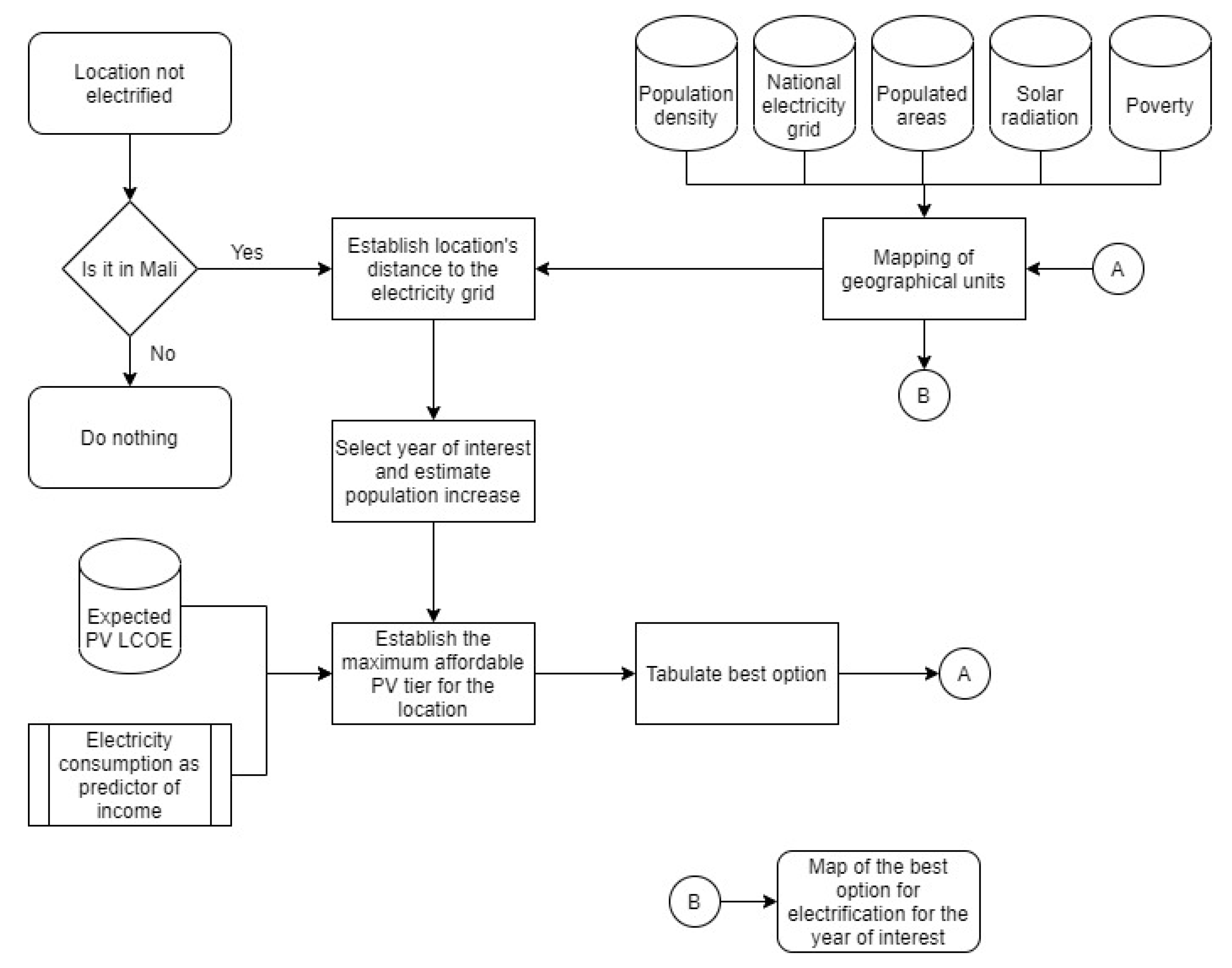

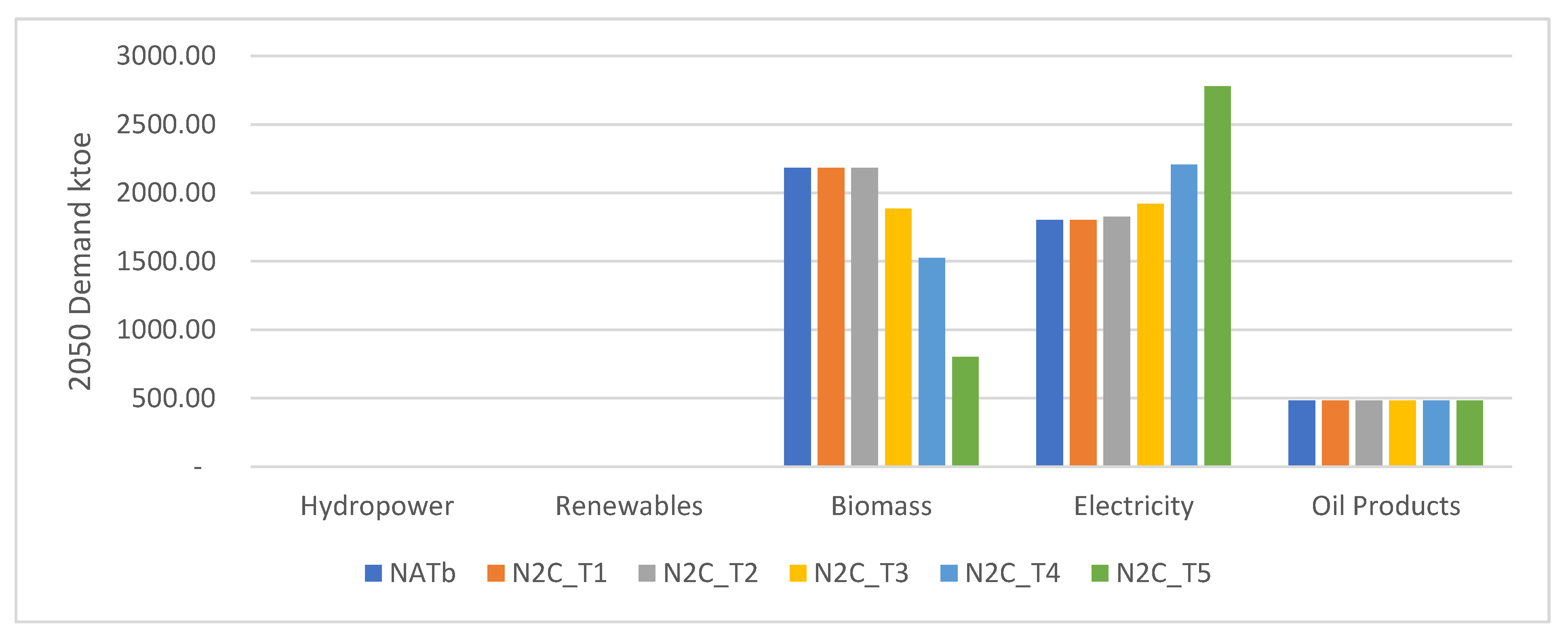
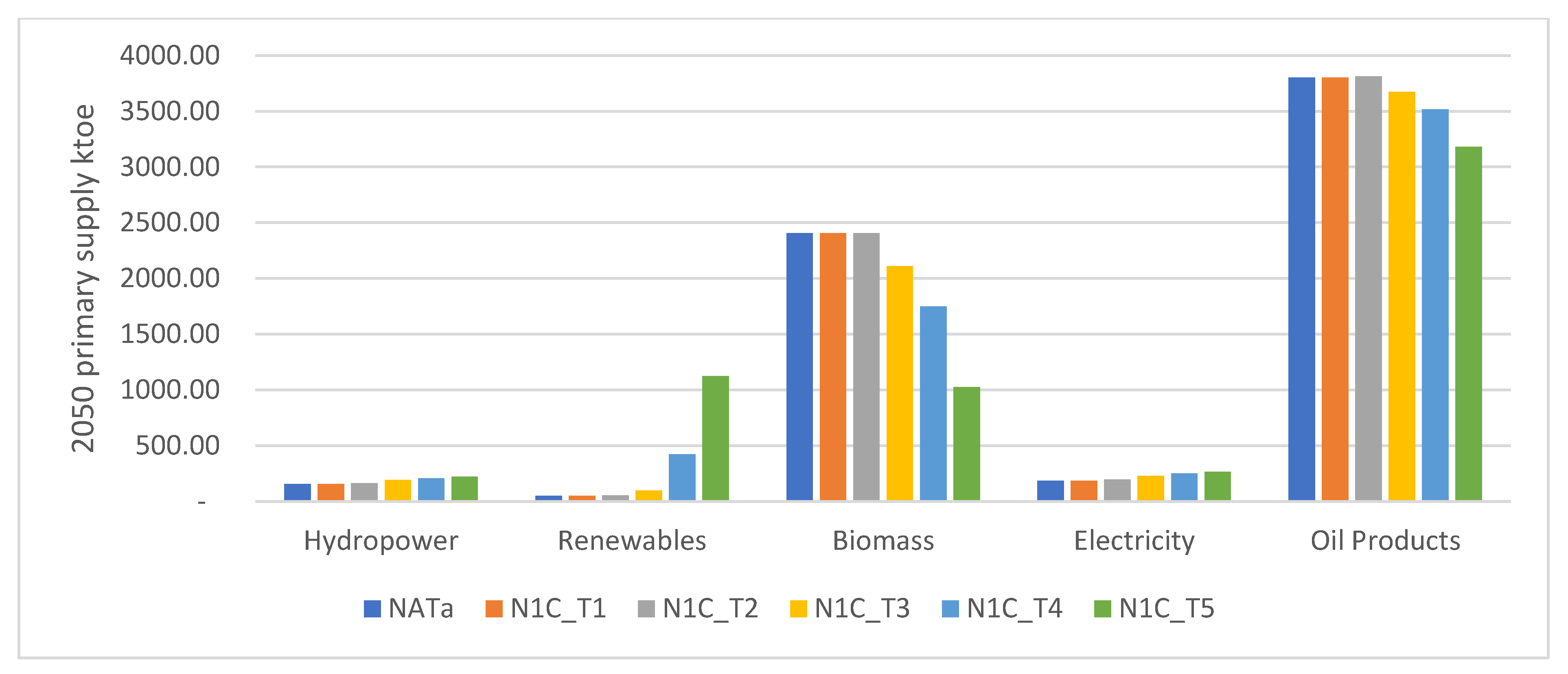

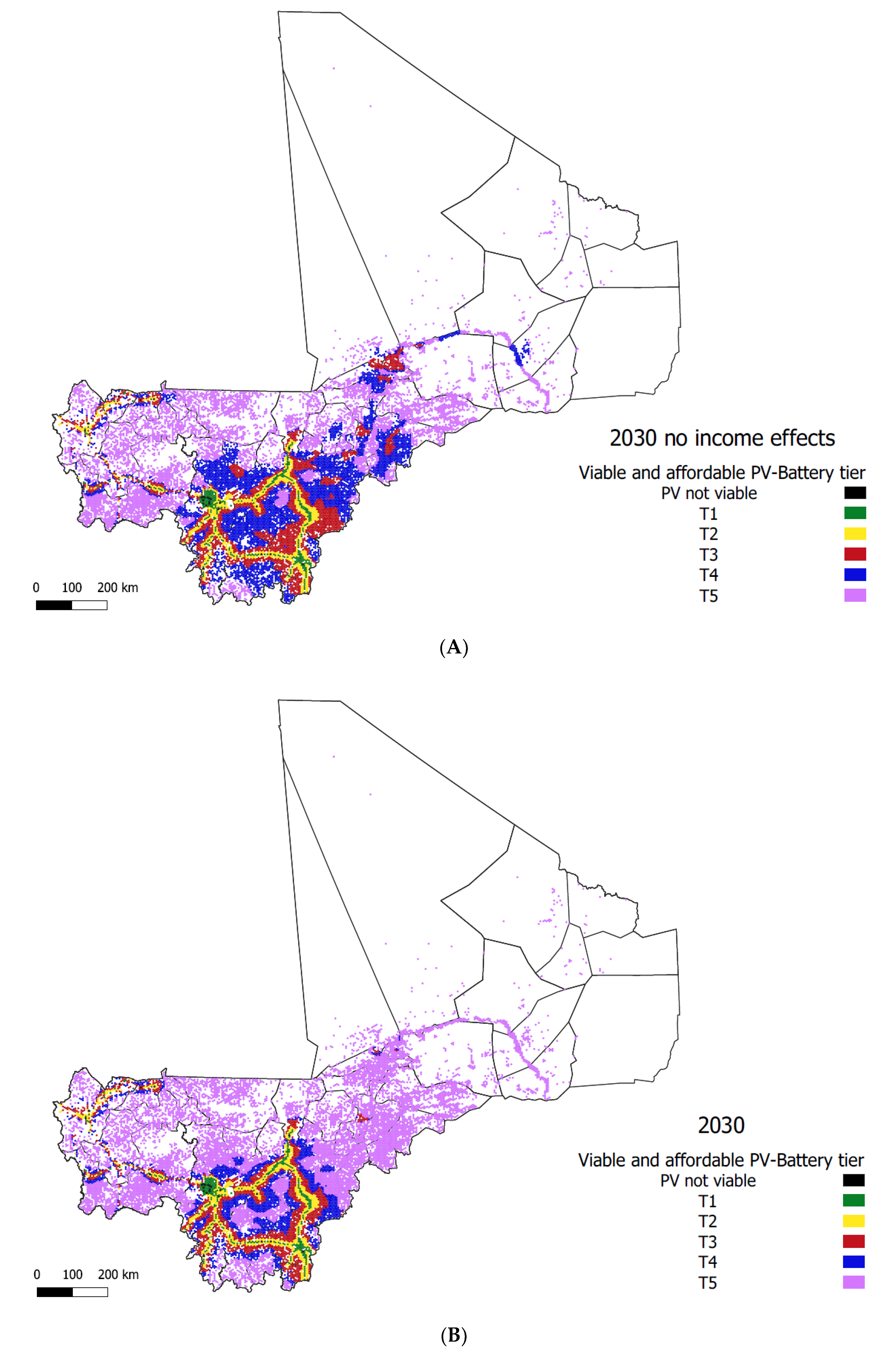

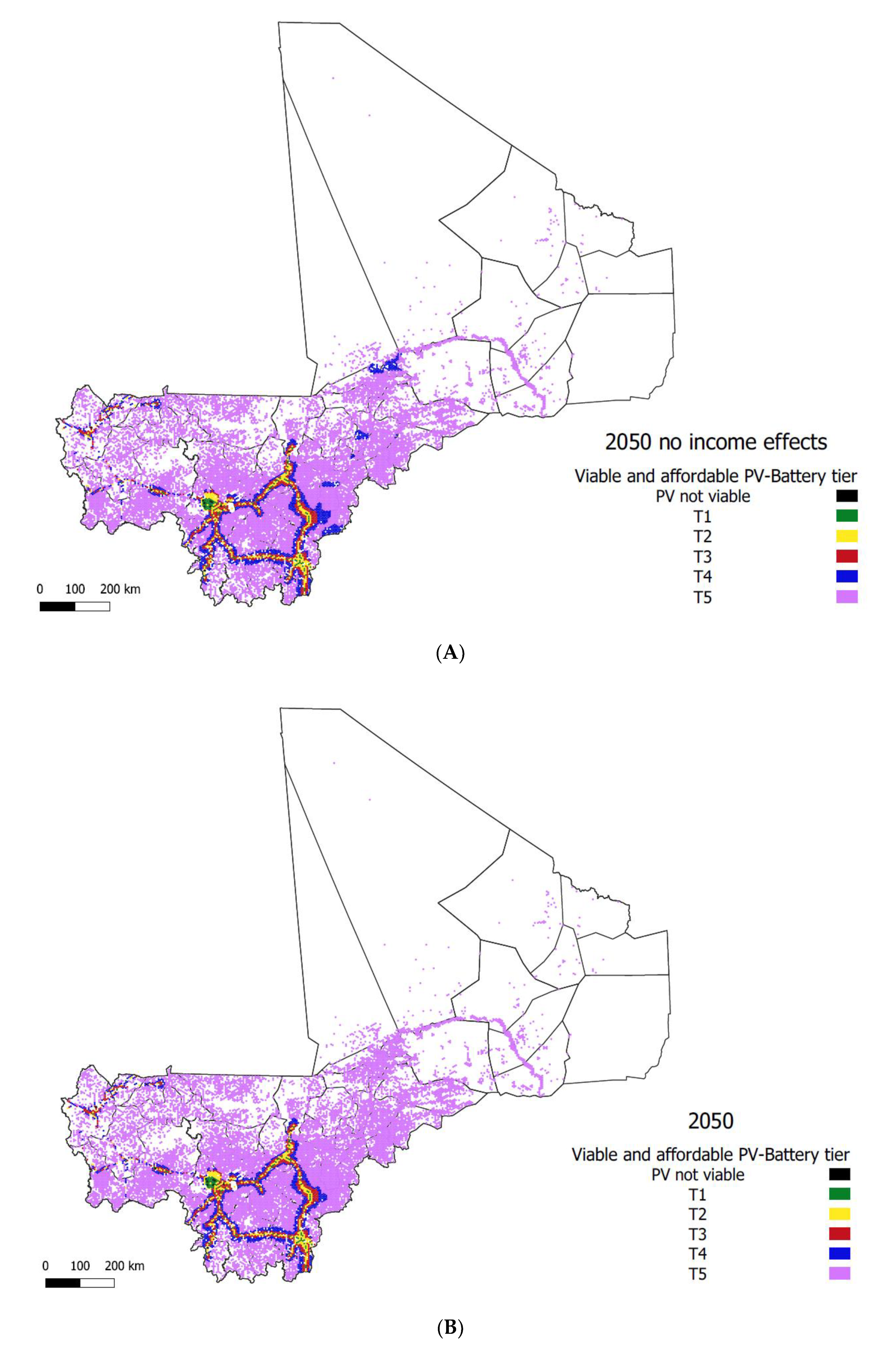
| Ktoe | Status | Biomass | Electricity | Petroleum Products |
|---|---|---|---|---|
| Urban | Electrified | 986.86 | 40.83 | 2.95 |
| Non-elect. | 160.65 | 0 | 0.89 | |
| Rural | Electrified | 294.09 | 12.34 | 2.41 |
| Non-elect. | 837.02 | 0 | 7.97 |
| Scenario | a | b | c | Scenario | a | b | c |
|---|---|---|---|---|---|---|---|
| N1C_T1 = | NATa + | COM + | T1 | N2C_T1 = | NATb + | COM + | T1 |
| N1C_T2 = | NATa + | COM + | T2 | N2C_T2 = | NATb + | COM + | T2 |
| N1C_T3 = | NATa + | COM + | T3 | N2C_T3 = | NATb + | COM + | T3 |
| N1C_T4 = | NATa + | COM + | T4 | N2C_T4 = | NATb + | COM + | T4 |
| N1C_T5 = | NATa + | COM + | T5 | N2C_T5 = | NATb + | COM + | T5 |
| Scenario | NATa | NATb | ||
|---|---|---|---|---|
| Urban electrification rates | 95% on 2021 | 95% on 2021 | ||
| Rural electrification rates | 45% on 2030, 77% by 2050 | 31% on 2030 | ||
| Urban consumption | Electricity | Electrified | 3%/year growth | 0.4 toe per household on 2030 |
| Biomass | Electrified | 0% on 2030 | 0% on 2030 | |
| Not electrified | 0% on 2030 | |||
| LPG | Electrified | 0.4 toe per household on 2030 | ||
| Not electrified | 0.4 toe per household on 2030 | |||
| Rural consumption | Electricity | Electrified | ||
| Biomass | Electrified | 0% on 2030 | 0% on 2030 | |
| Not electrified | ||||
| LPG | Electrified | 0.2 toe per household on 2030 | ||
| Not electrified | ||||
| Tier | Min Daily Capacity Per Household (W) | Biomass Reduced by Using Electricity (%) |
|---|---|---|
| T1 | 3 1 | 0 |
| T2 | 50 1 | 0 |
| T3 | 200 1 | 20 |
| T4 | 800 1 | 40 |
| T5 | 2000 1 | 80 |
| Scenario | Year | Biomass Red |
|---|---|---|
| No income effects 1 | 2030 | 50% |
| 2040 | 64% | |
| 2050 | 70% | |
| With income effects 2 | 2030 | 60% |
| 2040 | 67% | |
| 2050 | 71% |
Publisher’s Note: MDPI stays neutral with regard to jurisdictional claims in published maps and institutional affiliations. |
© 2021 by the authors. Licensee MDPI, Basel, Switzerland. This article is an open access article distributed under the terms and conditions of the Creative Commons Attribution (CC BY) license (https://creativecommons.org/licenses/by/4.0/).
Share and Cite
Sessa, V.; Bhandari, R.; Ba, A. Rural Electrification Pathways: An Implementation of LEAP and GIS Tools in Mali. Energies 2021, 14, 3338. https://doi.org/10.3390/en14113338
Sessa V, Bhandari R, Ba A. Rural Electrification Pathways: An Implementation of LEAP and GIS Tools in Mali. Energies. 2021; 14(11):3338. https://doi.org/10.3390/en14113338
Chicago/Turabian StyleSessa, Vittorio, Ramchandra Bhandari, and Abdramane Ba. 2021. "Rural Electrification Pathways: An Implementation of LEAP and GIS Tools in Mali" Energies 14, no. 11: 3338. https://doi.org/10.3390/en14113338
APA StyleSessa, V., Bhandari, R., & Ba, A. (2021). Rural Electrification Pathways: An Implementation of LEAP and GIS Tools in Mali. Energies, 14(11), 3338. https://doi.org/10.3390/en14113338






